From the Trenches
A Traditional Neanderthal Home
By ZACH ZORICH
Monday, February 13, 2017
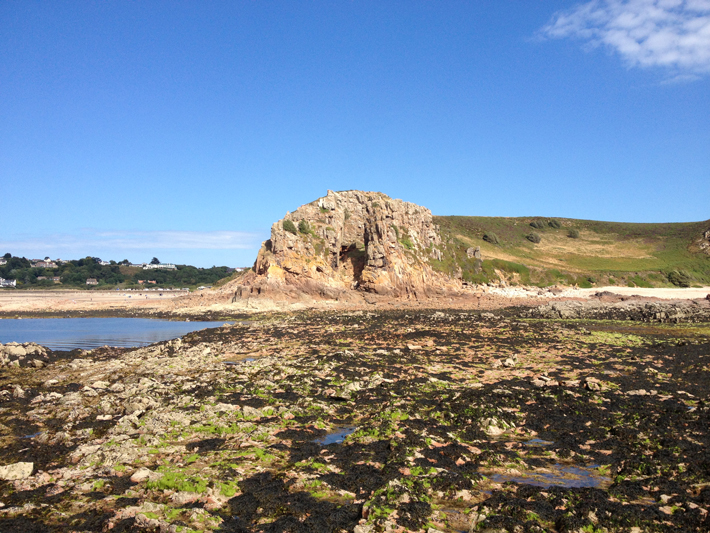
Rising out of the English Channel on the island of Jersey is one of the longest-occupied Neanderthal sites in the world. “La Cotte de Saint Brelade is this mega-site, a massive, deeply ravined granite headland on the far corner of northwest Europe providing a record spanning more than 200,000 years,” says Matthew Pope, a geoarchaeologist at University College London. The question that Pope and the Crossing the Threshold project research team is asking is what makes a site like La Cotte a “persistent” place? Why was this location occupied across millennia, even as the environmental conditions changed? There are several possible answers the team is investigating.
When Neanderthals lived at the site, between 240,000 and 40,000 years ago, the English Channel was dry land and the granite rock formation may have been an important landmark. According to Pope, around this time, hominins started to use fire regularly, and innovated new tool technologies and hunting practices. This may have pushed Neanderthals to start thinking differently about how they used the resources of the landscapes around them and changed how they thought about the places they called home.
Siberian William Tell
By ERIC A. POWELL
Monday, February 13, 2017
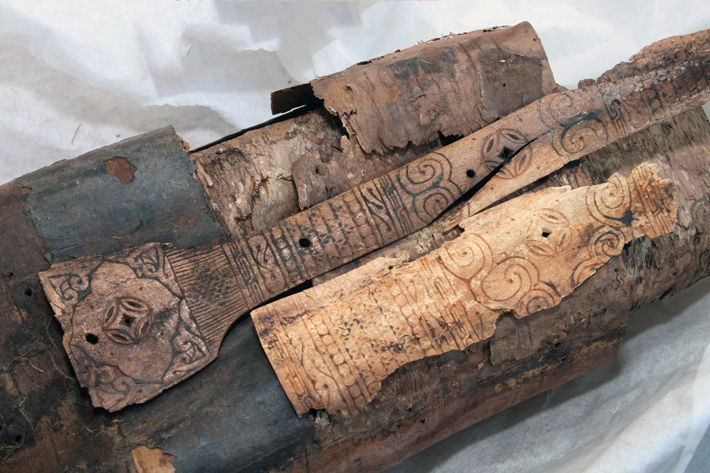 In the Siberian Altai region, two local residents recently discovered the burial of a medieval man in a cliff-face crevice. They reported the find to local museum officials and turned over a number of artifacts interred with the man, including an intricately decorated birch-bark quiver and iron-tipped arrows, which are now being studied and conserved by a team led by archaeologist Nikita Konstantinov of Gorno-Altaisk State University. Konstantinov believes that the archer lived sometime between the thirteenth and fifteenth centuries, a period when the Mongolian Empire’s Golden Horde ruled the area. “Here in the Altai we have very few sites dating to this era,” says Konstantinov. “This burial is well preserved, so it should help us to better understand the Mongolian period.” His team will fully investigate the site during the upcoming field season.
In the Siberian Altai region, two local residents recently discovered the burial of a medieval man in a cliff-face crevice. They reported the find to local museum officials and turned over a number of artifacts interred with the man, including an intricately decorated birch-bark quiver and iron-tipped arrows, which are now being studied and conserved by a team led by archaeologist Nikita Konstantinov of Gorno-Altaisk State University. Konstantinov believes that the archer lived sometime between the thirteenth and fifteenth centuries, a period when the Mongolian Empire’s Golden Horde ruled the area. “Here in the Altai we have very few sites dating to this era,” says Konstantinov. “This burial is well preserved, so it should help us to better understand the Mongolian period.” His team will fully investigate the site during the upcoming field season.
Bathing, Ancient Roman Style
By JARRETT A. LOBELL
Monday, February 13, 2017
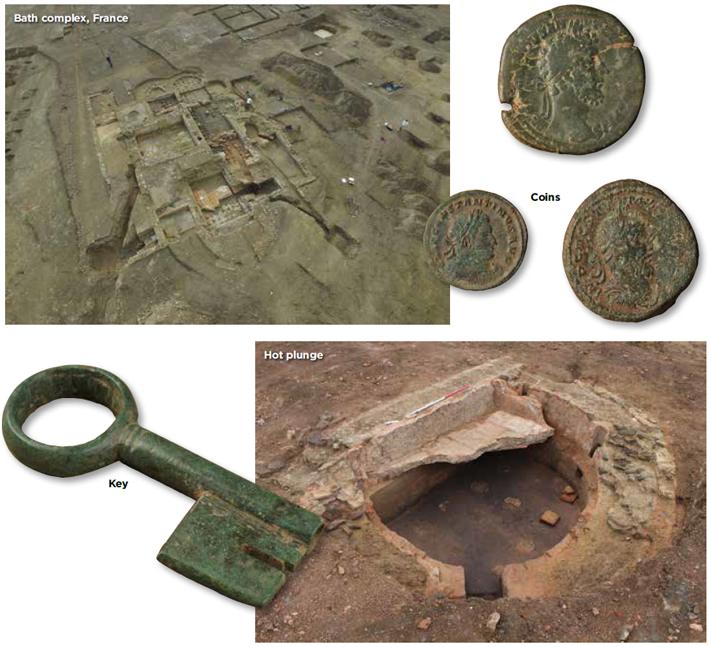
At a construction site in Langrolay-sur-Rance, in northwestern France, archaeologists from the National Institute for Preventive Archaeological Research have uncovered a vast ancient Roman estate, including the remains of its well-preserved bathhouse. The large property, with its main house, gardens, colonnaded walkways, heated floors, attached stables, and stunning view across the Rance River, likely would have been the country retreat for a wealthy family from the city of Fanum Martis, some eight miles away. The most exceptional remains excavated there are those of the luxurious bathhouse that sprawls across more than 4,000 square feet. Each stage of the standard Roman bathing routine could be followed at the villa, as one proceeded from the room for undressing, to the footbaths, the cold and hot pools, the heated room called the caldarium with its hot-water bath and sauna, and finally the heated massage room and a bracing cold plunge.
The Church that Transformed Norway
By ZACH ZORICH
Monday, February 13, 2017
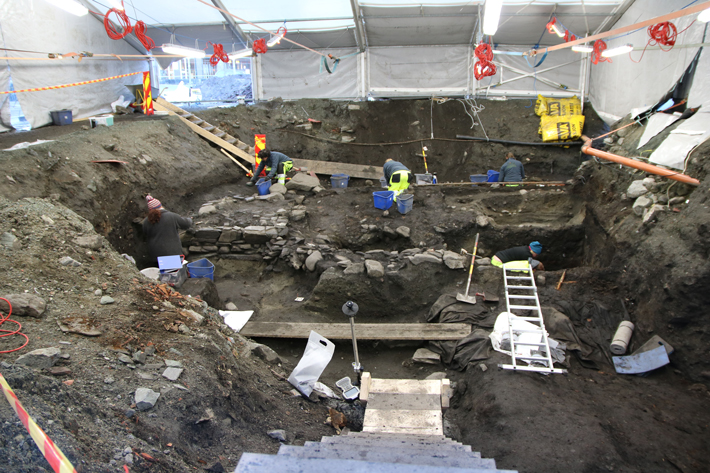
When King Olaf Haraldsson gave up the old Viking gods to become Norway’s first Christian ruler, he fundamentally changed his society. Part of that legacy is the church he built in his capital city of Nidaros (now known as Trondheim), which was recently discovered at the construction site of a new office building. The church’s stone foundation is remarkably intact. According to Anna Petersén of the Norwegian Institute for Cultural Heritage Research, the nave, choir, entrances, and foundation of the altar are still in place. The church was dedicated to Saint Clements the patron of slaves and seafarers and a popular figure among observant Norse raiders. A series of radiocarbon dates shows that the church was built in the early eleventh century, which affirms historical descriptions.
Researchers also found a construction behind the altar that they are calling the “Pall,” the place where they believe Haraldsson was laid to rest after he was martyred in the Battle of Stiklestad in 1030. Petersén says the church became such a popular pilgrimage site that the king’s coffin was later removed to a larger cathedral. The discovery of Haraldsson’s old church gives the research team an opportunity to reconstruct the royal compound and the city’s religious landscape at a time of profound spiritual change.
Neolithic FaceTime
By DANIEL WEISS
Monday, February 13, 2017
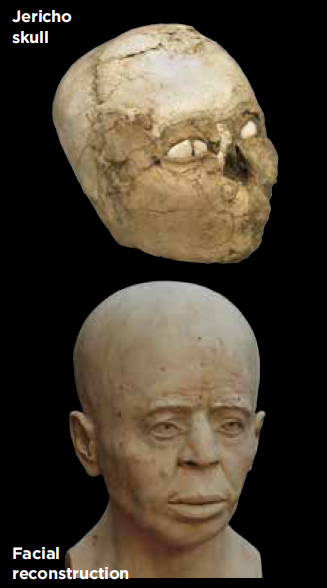 Forensic experts have reconstructed the face of a man who lived around 9,500 years ago in Jericho, near the Jordan River in the West Bank. The reconstruction was based on a micro-CT scan of his skull, which had been covered in plaster and has clamshells for eyes. Alexandra Fletcher of the British Museum, where the skull is housed, believes it and others like it were created as part of an ancestor cult.
Forensic experts have reconstructed the face of a man who lived around 9,500 years ago in Jericho, near the Jordan River in the West Bank. The reconstruction was based on a micro-CT scan of his skull, which had been covered in plaster and has clamshells for eyes. Alexandra Fletcher of the British Museum, where the skull is housed, believes it and others like it were created as part of an ancestor cult.
The scan reveals that the skull belonged to a man who died after the age of 40 and had a broken nose that healed during his lifetime. In addition, his skull had been tightly bound from early infancy, changing its shape. “This person lived a very long time ago,” says Fletcher, “but he could go out shopping in London today, and nobody would turn a hair. He’s a modern human, just like you or me.”
Advertisement
Advertisement
IN THIS ISSUE
Features
The First American Revolution
Kings of Cooperation
The Road Almost Taken
Letter from Philadelphia
From the Trenches
Digging up Digital Music
Off the Grid
Revisiting Montezuma Castle
Secret Spaces
Something New for Sutton Hoo
A Surprise City in Thessaly
Zinc Zone
Behind the Curtain
Royal Gams
A Mix of Faiths
Neolithic FaceTime
Bathing, Ancient Roman Style
The Church that Transformed Norway
Siberian William Tell
A Traditional Neanderthal Home
Artifact
Self-expression in the Bronze Age
Advertisement

Recent Issues
-
 May/June 2024
May/June 2024
-
 March/April 2024
March/April 2024
-
 January/February 2024
January/February 2024
-
 November/December 2023
November/December 2023
-
 September/October 2023
September/October 2023
-
 July/August 2023
July/August 2023
-
 May/June 2023
May/June 2023
-
 March/April 2023
March/April 2023
-
 January/February 2023
January/February 2023
-
 November/December 2022
November/December 2022
-
 September/October 2022
September/October 2022
-
 July/August 2022
July/August 2022
-
 May/June 2022
May/June 2022
-
 March/April 2022
March/April 2022
-
 January/February 2022
January/February 2022
-
 November/December 2021
November/December 2021
-
 September/October 2021
September/October 2021
-
 July/August 2021
July/August 2021
-
 May/June 2021
May/June 2021
-
 March/April 2021
March/April 2021
-
 January/February 2021
January/February 2021
-
 November/December 2020
November/December 2020
-
 September/October 2020
September/October 2020
-
 July/August 2020
July/August 2020
-
 May/June 2020
May/June 2020
-
 March/April 2020
March/April 2020
-
 January/February 2020
January/February 2020
-
 November/December 2019
November/December 2019
-
 September/October 2019
September/October 2019
-
 July/August 2019
July/August 2019
-
 May/June 2019
May/June 2019
-
 March/April 2019
March/April 2019
-
 January/February 2019
January/February 2019
-
 November/December 2018
November/December 2018
-
 September/October 2018
September/October 2018
-
 July/August 2018
July/August 2018
-
 May/June 2018
May/June 2018
-
 March/April 2018
March/April 2018
-
 January/February 2018
January/February 2018
-
 November/December 2017
November/December 2017
-
 September/October 2017
September/October 2017
-
 July/August 2017
July/August 2017
-
 May/June 2017
May/June 2017
-
 March/April 2017
March/April 2017
-
 January/February 2017
January/February 2017
-
 November/December 2016
November/December 2016
-
 September/October 2016
September/October 2016
-
 July/August 2016
July/August 2016
-
 May/June 2016
May/June 2016
-
 March/April 2016
March/April 2016
-
 January/February 2016
January/February 2016
-
 November/December 2015
November/December 2015
-
 September/October 2015
September/October 2015
-
 July/August 2015
July/August 2015
-
 May/June 2015
May/June 2015
-
 March/April 2015
March/April 2015
-
 January/February 2015
January/February 2015
-
 November/December 2014
November/December 2014
-
 September/October 2014
September/October 2014
-
 July/August 2014
July/August 2014
-
 May/June 2014
May/June 2014
-
 March/April 2014
March/April 2014
-
 January/February 2014
January/February 2014
-
 November/December 2013
November/December 2013
-
 September/October 2013
September/October 2013
-
 July/August 2013
July/August 2013
-
 May/June 2013
May/June 2013
-
 March/April 2013
March/April 2013
-
 January/February 2013
January/February 2013
-
 November/December 2012
November/December 2012
-
 September/October 2012
September/October 2012
-
 July/August 2012
July/August 2012
-
 May/June 2012
May/June 2012
-
 March/April 2012
March/April 2012
-
 January/February 2012
January/February 2012
-
 November/December 2011
November/December 2011
-
 September/October 2011
September/October 2011
-
 July/August 2011
July/August 2011
-
 May/June 2011
May/June 2011
-
 March/April 2011
March/April 2011
-
 January/February 2011
January/February 2011
Advertisement






